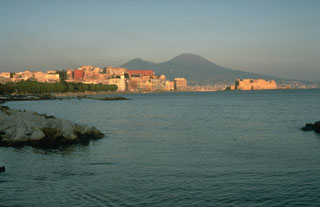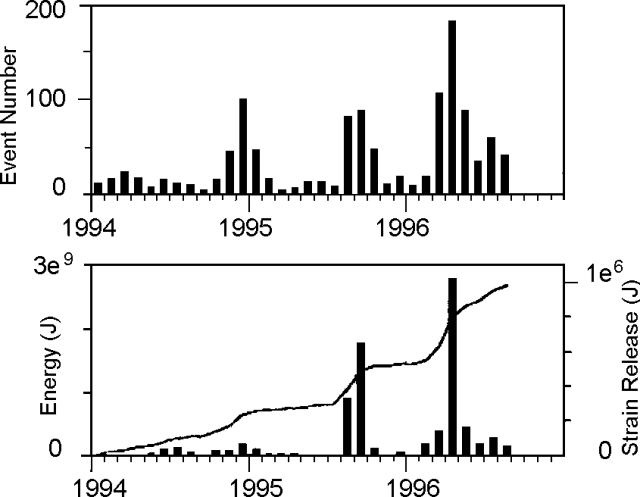Report on Vesuvius (Italy) — August 1996
Bulletin of the Global Volcanism Network, vol. 21, no. 8 (August 1996)
Managing Editor: Richard Wunderman.
Vesuvius (Italy) Ongoing sub-crater seismic activity
Please cite this report as:
Global Volcanism Program, 1996. Report on Vesuvius (Italy) (Wunderman, R., ed.). Bulletin of the Global Volcanism Network, 21:8. Smithsonian Institution. https://doi.org/10.5479/si.GVP.BGVN199608-211020
Vesuvius
Italy
40.821°N, 14.426°E; summit elev. 1281 m
All times are local (unless otherwise noted)
Non-eruptive activity at the Mt. Somma-Vesuvius volcanic complex is characterized by low seismicity both in terms of energy and numbers of events; very few episodes of intense seismicity occurred during the last twenty years.
In the last three years, however, hundreds of earthquakes have been detected with magnitudes ranging from -0.4 up to 3.4. The plot of monthly seismic events (figure 2) shows the usual fluctuating pattern observed at Vesuvius. The energy release distribution (figure 2) has a sharp peak coinciding with the 1995-96 earthquakes; the strain release curve also recorded two clear steps at these times.
After the seismic crisis of March-April 1996 (BGVN 21:06), seismic activity decreased. During May-August 1996, the permanent seismic network of the Osservatorio Vesuviano recorded 266 microearthquakes, the strongest one had M 2.7. The events belonging to this sequence affected an extremely reduced volume below the crater area at shallow depth, with hypocenters rarely exceeding 6 kilometers below the sea. No changes in ground deformation or fumarolic gas composition were reported in the last field measurements.
Geological Summary. One of the world's most noted volcanoes, Vesuvius (Vesuvio) forms a dramatic backdrop to the Bay of Naples. The active cone was constructed within a large caldera of the older Monte Somma edifice, thought to have formed incrementally beginning about 17,000 years ago. The Monte Somma caldera wall has channeled lava flows and pyroclastic flows primarily to the south and west. Eight major explosive eruptions have taken place in the last 17,000 years, often accompanied by large pyroclastic flows and surges, such as during the 79 CE Pompeii eruption. Intermittent eruptions since 79 CE were followed by a period of frequent long-term explosive and effusive eruptions between 1631 and 1944. The large 1631 eruption produced pyroclastic flows that reached as far as the coast and caused great destruction. Many towns are located on the flanks, and several million people live within areas that could be affected by eruptions.
Information Contacts: Lucia Civetta, Francesca Bianco, Giuseppe Vilardo, and Mario Castellano, Osservatorio Vesuviano, Via Manzoni 249, 80123 Napoli, Italy.


